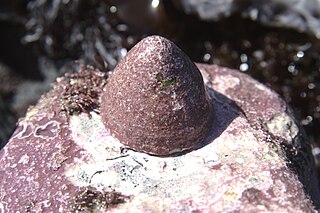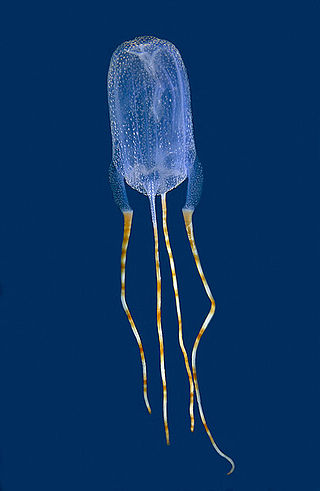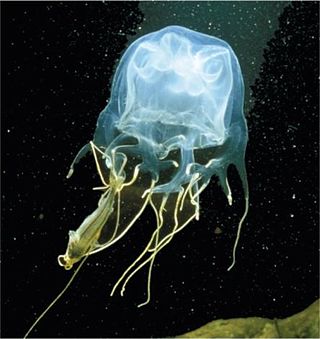
Ernst Heinrich Philipp August Haeckel was a German zoologist, naturalist, eugenicist, philosopher, physician, professor, marine biologist and artist. He discovered, described and named thousands of new species, mapped a genealogical tree relating all life forms and coined many terms in biology, including ecology, phylum, phylogeny, and Protista. Haeckel promoted and popularised Charles Darwin's work in Germany and developed the influential but no longer widely held recapitulation theory claiming that an individual organism's biological development, or ontogeny, parallels and summarises its species' evolutionary development, or phylogeny.

Grigore Antipa was a Romanian naturalist, zoologist, ichthyologist, ecologist, oceanologist, Darwinist biologist who studied the fauna of the Danube Delta and the Black Sea. Between 1892 and 1944 he was the director of the Bucharest Natural History Museum, which now bears his name. He is also considered to be the first person to modernize the diorama by emphasizing the three-dimensional aspect and first to use dioramas in a museum setting. He is the scientist who reorganized the Grigore Antipa National Museum of Natural History in the new building that today bears his name, designed by the architect Grigore Cerchez, built in 1906 and inaugurated by Carol I of Romania in 1908. He was elected as member of the Romanian Academy in 1910 and was also a member of several foreign academies. Grigore Antipa founded a school of hydrobiology and ichthyology in Romania.

Cassiopea is a genus of true jellyfish and the only members of the family Cassiopeidae. They are found in warmer coastal regions around the world, including shallow mangrove swamps, mudflats, canals, and turtle grass flats in Florida, and the Caribbean and Micronesia. The medusa usually lives upside-down on the bottom, which has earned them the common name. These jellyfish partake in a symbiotic relationship with photosynthetic dinoflagellates and therefore, must lie upside-down in areas with sufficient light penetration to fuel their energy source. Where found, there may be numerous individuals with varying shades of white, blue, green and brown.

Crown jellyfishes are the six families of true jellyfish that belong to the order Coronatae. They are distinguished from other jellyfish by the presence of a deep groove running around the umbrella, giving them the crown shape from which they take their name. Many of the species in the order inhabit deep sea environments.

The Polyceridae are a taxonomic family of sea slugs, dorid nudibranchs, marine gastropod mollusks within the superfamily Polyceroidea.

Atolla is a genus of crown jellyfish in the order Coronatae. The genus Atolla was originally proposed by Haeckel in 1880 and elevated to the monotypic family level, as Atollidae by Henry Bigelow in 1913. The six known species inhabit the mesopelagic zone. The medusae possess multiple lobes called lappets at the bell margin. Medusae also have eight tentacles, alternating with eight rhopalia, and twice as many lappets occur as tentacles.

Acmaea is a genus of sea snails, specifically true limpets, marine gastropod mollusks in the family Acmaeidae, one of the families of true limpets.

Pleurobrachia is a common genus of Ctenophora(an exclusively marine phylum). Along with the genus Hormiphora, it generally has the common name sea gooseberry. It contains the following species:

Lucernariidae is a family of stalked jellyfish containing two genera.

Olindiidae is a family of hydrozoans in the order Limnomedusae. They have a polyp phase and a medusa phase. The polyps are generally small (1 mm) and solitary, but a few species are colonial. They have a varying number of tentacles and can reproduce by budding. In the largest species, the medusae can grow to 15 cm (6 in). Centripetal canals may be present or absent and the radial canals are unbranched. The gonads are beside the radial canals, except in Limnocnida, where they are on the manubrium. The fertilised eggs develop into planula larvae which become polyps. These multiply asexually or can bud off medusae. In some species, medusae are only produced when the water temperature exceeds a certain level. Most species are marine, but several can also be found in brackish water and a few, notably Craspedacusta and Limnocnida, are found in fresh water.

Tamoya is a genus of box jellyfish within the monotypic family Tamoyidae.

Rhizostomatidae is a family of cnidarians in the class Scyphozoa.

Cimbex is a genus of sawflies in the family Cimbicidae.

Chirodropus is a genus of box jellyfish in the family Chirodropidae.

Dendrodoa is a genus of ascidian tunicates in the family Styelidae.

Aglantha is a genus of deep-sea hydrozoans of the family Rhopalonematidae.

Nausithoe is a genus of jellyfishes belonging to the family Nausithoidae.
Linuche is a genus of cnidarians belonging to the family Linuchidae.















